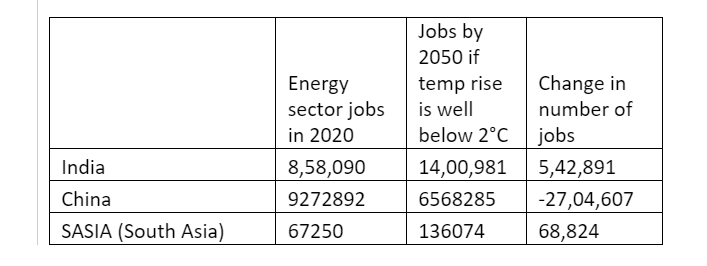
Switching to Renewable Energy Will Add 5 Lakh Jobs in India By 2050, Finds Study
The reason this happens is because low-carbon technologies are more job-intensive. That would lead to an increase in the number of jobs, especially during the expansion of renewable energy capacity.
New Delhi : The refrain to justify not moving away from fossil fuels has been that it would put people out of work. Coal and petroleum are big employers. India alone has about 8.6 lakh energy jobs now. But a new study has found that phasing out fossil fuels would actually add 80 lakh energy sector jobs across the world by 2050, of which over 5.4 lakh would be in India.
“Climate action results in more jobs,” Dr Sandeep Pai, co-author of the paper published in ‘One Earth’ journal on Friday, told TOI. Data he shared show that if the Paris Agreement target of temperature rise staying well below 2°C werema met, the number of jobs in India’s energy sector would go up from 8.6 lakh to 14 lakh by 2050. The rest of South Asia, meanwhile, would add about 69,000 jobs. China, on the other hand, would lose over 27 lakh jobs. “According to our study, the US and Middle East and North Africa are clear winners in terms of adding maximum numbers of jobs. They all add over a million jobs by 2050,” Pai said.
The reason this happens is because low-carbon technologies are more job-intensive. That would lead to an increase in the number of jobs, especially during the expansion of renewable energy capacity. “The emerging economies of Indonesia, South East Asia, Brazil, India, and South Asia currently have a large number of jobs in the fossil fuel sector … In our WB2C (global temperature rise well below 2°C) scenarios, while their fossil fuel jobs decrease, the increase in energy demand and massive deployment of renewables leads to an overall rise in jobs,” the paper said.
But why the variation? “Job number differences are a complex mix of changes in job intensity, energy demand, and differing impacts of economic drivers associated with these regions. These drivers include population, GDP, urbanization etc,” Pai said. “But generally, China, which currently produces and consumes half of the world’s coal, has over 6 million coal jobs. In the future, while this massive coal sector declines (and so do the associated jobs) and new renewable jobs are created, they are not enough to compensate for the losses in coal jobs. In India’s case, the majority of Indian jobs are also in the coal sector (over 0.5 million) which decline but gains in renewable jobs more than make up for the lost jobs.”
The study is the first based on a comprehensive dataset of over 50 countries, which the researchers combined with an integrated assessment model to make job projections. “There have been past studies on this but most of them used OECD (Organisation for Economic Cooperation and Development) datasets and applied regional multipliers to calculate job impacts in non-OECD countries,” Pai said. “This was a big gap as India and China are the major fossil fuel and renewable energy producers. So, we wanted to fill this big knowledge gap … (Also), most of the global studies on energy transitions focus on technical and economic aspects of clean energy transitions but ignore the very important socio-economic factors associated with the transition. We wanted to highlight the human side or social impacts of energy transitions.”















